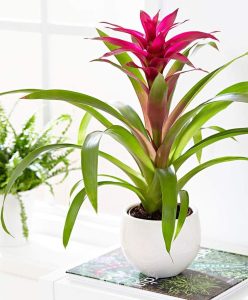Guzmania lingulata

- Botanical Name: Guzmania lingulata (L.) Mez
- Family Name: Bromeliaceae
- Stems: 12-16 inches
- Temperature: 15-32℃
- Others: Likes warmth , moisture, avoids cold and direct sun.
Overview
Product Description
Totally Tropical Troubles: Guzmania lingulata’s Battle with Bugs and Blight
The Lush Life of Guzmania lingulata: A Tropical Enigma
The Green Star of the Rainforest
Guzmania lingulata, a perennial evergreen herb of the Bromeliaceae family, can reach a height of 80 centimeters with short stems and alternate long, strap-like leaves that are usually basal and arranged in a rosette pattern. The leaves are light green with yellowish spots, concave on the upper side and sheath-like at the base, which helps rainwater flow into the water reservoir formed by the leaf sheath. In spring, Guzmania lingulata produces spikes of orange or scarlet flowers with slender styles and star-shaped bracts.

Guzmania lingulata
The Tropical Charm of Warmth and Humidity
Native to Central and South America, Guzmania lingulata is epiphytic on trees in tropical rainforests. They prefer warm, humid, and sunny environments to bloom properly and display their most beautiful leaves. The suitable growth temperature is 20-30°C in summer and 15-18°C in winter, with the minimum night temperature maintained above 5°C. Temperatures that are too high or too low can harm the plant, affecting its growth and flowering.
The Harmonious Symphony of Light and Moisture
Guzmania lingulata prefers a high-humidity environment, with the air humidity maintained between 75% and 85% to keep the plant plump and shiny. Light intensity is an important factor affecting the growth speed, plant form, flower shape, and color. The suitable light intensity is around 18,000 lux. During the seedling stage, the light intensity is controlled around 15,000 lux, which can be increased to 20,000 to 25,000 lux after three months.
The Concerto of Fresh Air and Pure Water
Good ventilation is crucial for the growth of Guzmania lingulata, especially during the high-temperature and high-humidity summer. With good ventilation, the plant is robust, with broad and thick leaves and bright flower colors; insufficient ventilation can lead to etiolation, dull color, and susceptibility to diseases and pests. In terms of water quality, the lower the salt content, the better. High levels of calcium and sodium can affect photosynthesis and cause diseases. The EC value should be controlled below 0.3, and the pH value should be between 5.5 and 6.5.
The Art of Precise Irrigation for Life-Giving Water
The root system of Guzmania lingulata is weak, mainly serving to anchor the plant, with secondary absorption functions. The nutrients and water they need are mainly stored in the tank formed by the base of the leaves, absorbed by the absorption scales at the base of the leaves. During the summer and autumn growing season, water demand is high, with water poured into the leaf tank every 4 to 5 days and into the medium every 15 days to keep the tank full and the medium moist. In winter, when the plant enters the dormant period, water the leaf tank every two weeks, and do not water the medium unless it is dry to prevent root rot.
Guzmania lingulata Woes: Diseases and Pests in the Tropical Jungle
Ornamental Guzmania lingulata face two types of diseases: non-infectious (physiological) and infectious (caused by microbes like fungi, bacteria, and viruses).
Two major diseases are heart rot and root rot, causing soft, smelly decay at the base of the leaf sheath and black, rotting root tips, respectively. These can be triggered by poor drainage, overwatering, water quality issues, improper seedling packaging, and high humidity.
Leaf tip yellowing and withering may result from alkaline water, low humidity, over-fertilization, or poor drainage. Pineapples, native to the tropics, are sensitive to cold and require temperatures above 5°C in winter.
The most common pest is scale insects, which suck sap and cause chlorotic spots on leaves, potentially leading to sooty mold.










